2015 Latest released Microsoft Official 70-243 Practice Exam Question Free Download From Braindump2go Now! All New Updated 103 Questions And Answers are Real Questions from Microsoft Exam Center!
Vendor: Microsoft
Exam Code: 70-243
Exam Name: Administering and Deploying System Center 2012 Configuration Manager
QUESTION 41
You have a System Center 2012 Configuration Manager environment.
You need to view the installation progress of an advertisement from a client computer.
Which log file should you view?
A. policyevaluator.log
B. ccmexec.log
C. execmgr.log
D. offermgr.log
Answer: C
QUESTION 42
Your network contains a System Center 2012 Configuration Manager environment.
You write the following query:
select SYS.Name from SMS_R_System SYS
join SMS_G_Syatem_ADD_REMOVE_PROGRAMS ARP
on ARP.ResourceId = SYS.ResourceId
You need to create a list of all the client computers that have a version of Visual Studio installed.
What should you add to the query?
A. where ARP.DisplayName like “Visual Studio*”
B. where ARP.DisplayName = “*Visual Studio*”
C. where ARP.DisplayNarae = “%%Visual Studio”
D. where ARP.DisplayName like “Visual studio%”
Answer: D
Explanation:
You need to use “Like” not “=” otherwise the WildCard “%” is seen as a real identifier. Better to use % compared to *. With % you would only get different versions of Visual Studio and not other applications with names starting with Visual Studio.
QUESTION 43
Your network contains a System Center 2012 Configuration Manager environment.
You need to receive an email message every day that lists all non-compliant clients.
What should you do?
A. Create an alert subscription.
B. Configure a Microsoft SQL Server Reporting Services (SSRS) report.
C. Configure an in-console alert.
D. Create a ConfigMgr query.
Answer: B
Explanation:
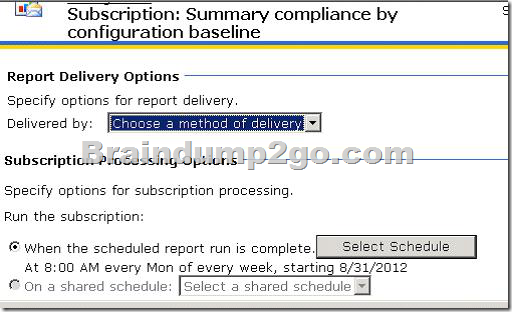
Configure report subscription is with the same procedure as standard SQL report service
http://be.enhansoft.com/post/2013/08/14/How-to-Set-up-an-Email-Subscription-in-SSRS.aspx
QUESTION 44
Note: This question is part of a series of questions that use the same set of answer choices.
An answer choice may be correct for more than one question in the series.
Your network contains a System Center 2012 Configuration Manager environment as shown in the exhibit. (Click the Exhibit button.)

The network contains six servers. The servers are configured as shown in the following table.
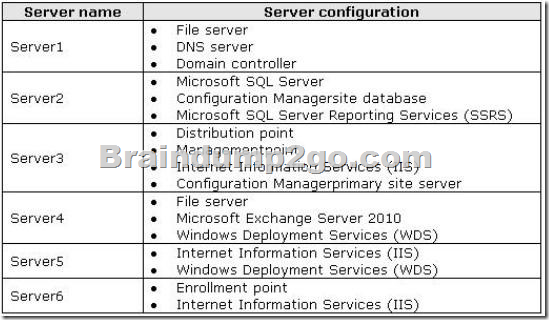
You plan to deploy servers to the perimeter network by using Configuration Manager.
The operating system for each server will be instated over the network.
The installations will begin automatically, as soon as each server starts for the first time.
You need to recommend a solution to minimize the amount of network traffic between the perimeter network and the internal network during the installation of the operating systems.
What should you do?
A. Install a software update point on Server3.
B. Configure IIS to support only HTTP on Server3.
C. Install a PXE-enabled protected distribution point on Servers.
D. Install a management point on Servers.
E. Install Windows Server Update Services (WSUS) on Server3.
F. Install Network Load Balancing (NLB) on Server6.
G. Install the Windows Cluster service on Server6.
H. Install a PXE-enabled protected distribution point on Server4.
I. Install a management point on Server2.
J. Install a protected distribution point on Server1.
K. Install the Windows Cluster service on Server3.
L. Install Network Load Balancing (NLB) on Server3.
M. Configure the Exchange connector on Server3.
N. Configure IIS to support only HTTPS on Servers.
O. Install an enrollment proxy point on Server6.
Answer: C
Explanation:
Administration, Site config, Servers and Site System Roles, DP role, properties, PXE tab

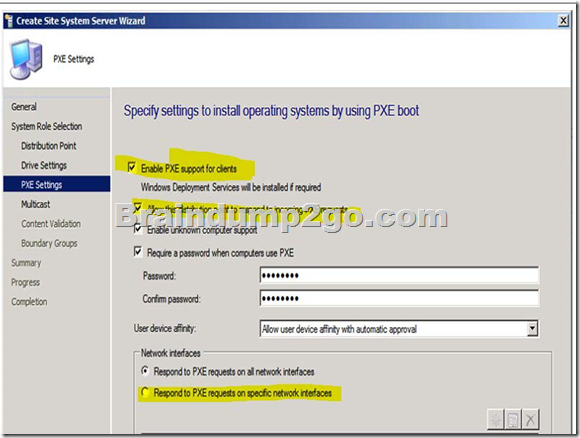
Topology Sample: http://technet.microsoft.com/en-us/library/bb633059.aspx
QUESTION 45
Note: This question is part of a series of questions that use the same set of answer choices.
An answer choice may be correct for more than one question in the series.
Your network contains a System Center 2012 Configuration Manager environment as shown in the exhibit. (Click the Exhibit button.)

The network contains six servers. The servers are configured as shown in the following table.
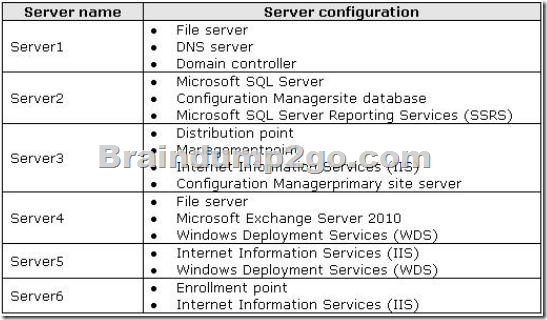
A corporate security policy states that remote computers are forbidden to communicate directly with servers on the internal network.
You need to ensure that you collect inventory data from the remote computers.
What should you do?
A. Install Windows Server Update Serves (WSUS) on Server3.
B. Configure the Exchange connector on Server3.
C. Install a management point on Server2.
D. Install a PXE-enabled protected distribution point on Servers.
E. Install a software update point on Server3.
F. Install Network Load Balancing (NLB) on Server6.
G. Install an enrollment proxy point on Server6.
H. Install the Windows Cluster service on Server3.
I. Install a protected distribution point on Server1.
J. Configure IIS to support only HTTPS on Servers.
K. Install a management point on Server5.
L. Install the Windows Cluster service on Server6.
M. Configure IIS to support only HTTP on Servers.
N. Install Network Load Balancing (NLB) on Server3.
O. Install a PXE-enabled protected distribution point on Server4.
Answer: K
Explanation:
http://technet.microsoft.com/en-us/library/gg712701.aspx
Planning for Communications in Configuration Manager
Planning for Communications Across Forests in Configuration Manager
When your Configuration Manager design spans multiple Active Directory domains and forests, use the additional information in the following table to help you plan for the following types of communication:
Communication in a site that spans forests:
Does not require a two-way forest trust.
To support clients primary sites support the installation of each site system role on computers in other forests.
Note: Two exceptions are the out of band service point and the Application Catalog web service point. Each must be installed in the same forest as the site server.
When the site system role accepts connections from the Internet, as a security best practice, install these site system roles in an untrusted forest (for example, in a perimeter network) so that the forest boundary provides protection for the site server.
When you specify a computer to be a site system server, you must specify the Site System Installation Account. This account must have local administrative credentials to connect to, and then install site system roles on the specified computer.
When you install a site system role in an untrusted forest, you must select the site system option Require the site server to initiate connections to this site system. This configuration enables the site server to establish connections to the site system server to transfer data. This prevents the site system server that is in the untrusted location from initiating contact with the site server that is inside your trusted network. These connections use the Site System Installation Account that you use to install the site system server.
The management point and enrollment point site system roles connect to the site database. By default, when these site system roles are installed, Configuration Manager configures the computer account of the new site system server as the connection account and adds the account to the appropriate SQL Server database role. When you install these site system roles in an untrusted domain, you must configure the site system role connection account to enable the site system role to obtain information from the database.
If you configure a domain user account for these connection accounts, ensure that the account has appropriate access to the SQL Server database at that site:
* Management point: Management Point Database Connection Account
* Enrollment point: Enrollment Point Connection Account
Consider the following additional information when you plan for site system roles in other forests:
* If you run a Windows Firewall, configure the applicable firewall profiles to pass communications between the site database server and computers that are installed with remote site system roles.
* When the Internet-based management point trusts the forest that contains the user accounts, user policies are supported. When no trust exists, only computer policies are supported.
QUESTION 46
Note: This question is part of a series of questions that use the same set of answer choices.
An answer choice may be correct for more than one question in the series.
Your network contains a System Center 2012 Configuration Manager environment as shown in the exhibit. (Click the Exhibit button.)

The network contains six servers. The servers are configured as shown in the following table.
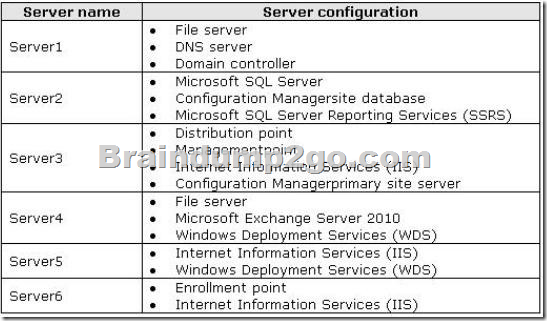
Administrators currently apply software updates to servers manually.
You discover that Server4 was never updated.
You need to centrally manage software updates for all of the servers by using configuration Manager.
What should you do first?
A. Install a management point on Server5.
B. Configure IIS to support only HTTPS on Servers.
C. Install a management point on Server2.
D. Install Network Load Balancing (NLB) on Server3.
E. Install an enrollment proxy point on Server6.
F. Configure IIS to support only HTTP on Server3.
G. Configure the Exchange connector on 5erver3.
H. Install Network Load Balancing (NLB) on 5erver6.
I. Install a PXE-enabled protected distribution point on Servers.
J. Install the Windows Cluster service on Server3.
K. Install a PXE-enabled protected distribution point on Server4
L. Install the Windows Cluster service on Server6.
M. Install Windows Server Update Services (WSUS) on Server3.
N. Install a protected distribution point on Server1.
O. Install a software update point on Server3.
Answer: M
Explanation:
A WSUS service will simplify and automate software updates for all servers from a single management interface.
QUESTION 47
You need to configure connectors between the System Center 2012 components to meet the administrative requirements.
Between which System Center 2012 components should you configure the connectors?
A. Operations Manager and Orchestrator
B. Service Manager and VMM
C. Operations Manager and Service Manager
D. Configuration Manager and Service Manager
Answer: C
QUESTION 48
Your company has a production network and a test network.
Both networks have System Center 2012 Configuration Manager deployed.
You create the following objects on the test network:
– A configuration item named SQLServerCI
– A configuration baseline named SQLServerBaseline that contains the configuration item
– A collection named SQLServers that contains all of the servers on the test network that run Microsoft SQL Server
You export the configuration baseline to SQLServerBaseline.cab.
You open the Configuration Manager console, you click Assets and Compliance, and then you expand Compliance Settings.
You need to apply the configuration baseline to the servers on the production network that run SQL Server.
You create a collection named SQLServers that contains all SQL Servers from the production network.
What should you do next? (Choose all that apply.)
A. Right-click SQLServersBaseline, select Categorize, and then select Server.
B. Right-click SQLServerCI, select Export, and then specify SQLServer Baseline.cab as the export file.
C. Right-click SQLServersBaseline, select Deploy, and then select the SQLServers collection.
D. Right-click Configuration Baselines, and then select Import Configuration Data
E. Right-click SQLServersBaseline, and then select Properties. In the Deployments tab, type SQLServers
in the Filter… box
Answer: CD
Explanation:
http://technet.microsoft.com/en-us/library/hh691016.aspx
How to Import Configuration Data in Configuration Manager
In addition to creating configuration baselines and configuration items in the System Center 2012 Configuration Manager console, you can import configuration data if it is contained in a cabinet (.cab) file format and adheres to the supported SML schema. You can import configuration data from the following sources:
Best practice configuration data (Configuration Packs) that has been downloaded from Microsoft or from other software vendor sites.
Configuration data that has been exported from System Center 2012 Configuration Manager.
Configuration data that was externally authored and that conforms to the Service Modeling Language (SML) schema.
How to Import Configuration Data
When you import a configuration baseline, some or all of the configuration items that are referenced in the configuration baseline might also be included in the cabinet file. During the import process, Configuration Manager verifies that all of the configuration items that are referenced in the configuration baseline are either also included in the cabinet file or already exist in the Configuration Manager site. The import process fails if you attempt to import a configuration baseline that references configuration data that Configuration Manager cannot locate.
To import configuration data
1. In the Configuration Manager console, click Assets and Compliance.
2. In the Assets and Compliance workspace, expand Configuration Items or Configuration Baselines, and then in the Home tab, in the Create group, click Import Configuration Data.
3. On the Select Files page of the Import Configuration Data Wizard, click Add, and then in the Open dialog box, select the .cab files you want to import.
4. Select the Create a new copy of the imported configuration baselines and configuration items check box if you want the imported configuration data to be editable in the Configuration Manager console.
5. On the Summary page of the wizard, review the actions that will be taken, and then complete the wizard.
The imported configuration data displays in the Compliance Settings node in the Assets
and Compliance workspace.
http://technet.microsoft.com/en-us/library/hh219289.aspx
How to Deploy Configuration Baselines in Configuration Manager
Configuration baselines in System Center 2012 Configuration Manager must be deployed to one or more collections of users or devices before client devices in those collections can assess their compliance with the configuration baseline.
Use the Deploy Configuration Baselines dialog box to define configuration baseline deployments, which includes adding or removing configuration baselines from deployments in addition to specifying the evaluation schedule.
To deploy a configuration baseline
1. In the Configuration Manager console, click Assets and Compliance.
2. In the Assets and Compliance workspace, expand Compliance Settings, and then click Configuration Baselines.
3. In the Configuration Baselines list, select the configuration baseline that you want to deploy, and then in the Home tab, in the Deployment group, click Deploy.
4. In the Deploy Configuration Baselines dialog box, select the configuration baselines that you want to deploy in the Available configuration baselines list. Click Add to add these to the selected configuration baselines list.
5. Specify the following additional information:
* Remediate noncompliant rules when supported – Enable this option to automatically remediate any rules that are noncompliant for Windows Management Instrumentation (WMI), the registry, scripts, and all settings for mobile devices that are enrolled by Configuration Manager.
* Allow remediation outside the maintenance window – If a maintenance window has been configured for the collection to which you are deploying the configuration baseline, enable this option to let compliance settings remediate the value outside of the maintenance window.
6. Generate an alert – Enable this option to configure an alert that is generated if the configuration baseline compliance is less than a specified percentage by a specified date and time. You can also specify whether you want an alert to be sent to System Center Operations Manager.
7. Collection: Click Browse to select the collection where you want to deploy the configuration baseline.
8. Specify the compliance evaluation schedule for this configuration baseline: Specifies the schedule by which the deployed configuration baseline is evaluated on client computers.
This can be either a simple or a custom schedule.
9. Click OK to close the Deploy Configuration Baselines dialog box and to create the deployment.
QUESTION 49
Drag and Drop Question
Your network contains a System Center 2012 Configuration Manager environment.
Your company has a security policy that contains mandatory registry settings for all servers.
You have a collection named Servers that contains all of the servers.
You need to identify which servers do not comply with the security policy.
What should you do?
To answer, move the four appropriate actions from the list of actions to the answer area and arrange them in the correct order.
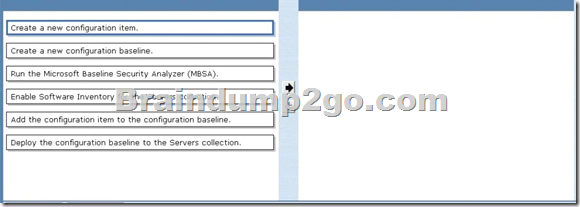
Answer:
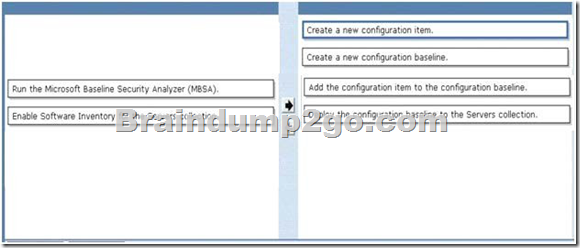
Explanation:
http://technet.microsoft.com/en-us/library/hh519648.aspx
Configuration Items in System Center 2012 – Service Manager
Configuration items are a way to store information about services, computers, software, software updates, users and other undefined imported objects in the Service Manager database in System Center 2012 – Service Manager.
You can then select configuration items when you submit forms, such as an incident form, a change request form, or a work item form.
http://technet.microsoft.com/en-us/library/gg712268.aspx
How to Create Configuration Baselines for Compliance Settings in Configuration Manager
Configuration baselines in System Center 2012 Configuration Manager contain predefined configuration items and optionally, other configuration baselines. After a configuration baseline is created, you can deploy it to a collection so that devices in that collection download the configuration baseline and assess their compliance with it.
To create a configuration baseline
In the Configuration Manager console, click Assets and Compliance.
In the Assets and Compliance workspace, expand Compliance Settings, and then click Configuration Baselines.
On the Home tab, in the Create group, click Create Configuration Baseline.
In the Create Configuration Baseline dialog box, enter a unique name and a description for the configuration baseline. You can use a maximum of 255 characters for the name and 512 characters for the description.
The Configuration data list displays all configuration items or configuration baselines that are included in this configuration baseline. Click Add to add a new configuration item or configuration baseline to the list. You can choose from the following:
* Configuration Items
* Software Updates
* Configuration Baselines
Use the Change Purpose list to specify the behavior of a configuration item that you have selected in the Configuration data list. You can select from the following:
* Required: The configuration baseline is evaluated as noncompliant if the configuration item is not detected on a client device. If it is detected, it is evaluated for compliance
* Optional: The configuration item is only evaluated for compliance if the application it references is found on client computers. If the application is not found, the configuration baseline is not marked as noncompliant (only applicable to application configuration items).
* Prohibited: The configuration baseline is evaluated as noncompliant if the configuration item is detected on client computers (only applicable to application configuration items).
Use the Change Revision list to select a specific or the latest revision of the configuration item to assess for compliance on client devices or select Always Use Latest to always use the latest revision.
If you want to remove a configuration item from the configuration baseline, select a configuration item, and then click Remove.
Click OK to close the Create Configuration Baseline dialog box and to create the configuration baseline.
http://technet.microsoft.com/en-us/library/hh219289.aspx
How to Deploy Configuration Baselines in Configuration Manager
Configuration baselines in System Center 2012 Configuration Manager must be deployed to one or more collections of users or devices before client devices in those collections can assess their compliance with the configuration baseline.
Use the Deploy Configuration Baselines dialog box to define configuration baseline deployments, which includes adding or removing configuration baselines from deployments in addition to specifying the evaluation schedule.
QUESTION 50
Your company has 2,000 desktop computers and 450 portable computers. The desktop computers run Windows 7 Enterprise (x64) and the portable computers run Windows 7 Professional (x86). The network contains a System Center 2012 Configuration Manager environment.
You create a configuration baseline that is targeted to all of the computers.
You discover that you fail to receive compliance information for the configuration baseline from the portable computers.
You receive compliance information for the configuration baseline from the desktop computers. You receive compliance information for other configuration baselines from all of the computers. You need to ensure that you receive compliance information for the configuration baseline from all of the computers.
What should you do?
A. Add the configuration item to a new configuration baseline.
B. Create a collection containing the portable computers and assign the configuration baseline
to the collection.
C. Create custom client settings for the portable computers and enable Compliance Settings.
D. Configure the configuration item to be evaluated on all Windows 7 operating systems.
Answer: D
Explanation:
http://technet.microsoft.com/en-us/library/gg682139.aspx
Introduction to Compliance Settings in Configuration Manager
Compliance settings in System Center 2012 Configuration Manager provides a unified interface and user experience that lets you manage the configuration and compliance of servers, laptops, desktop computers, and mobile devices in your organization. Compliance settings contains tools to help you assess the compliance of users and client devices for many configurations, such as whether the correct Windows operating system versions are installed and configured appropriately, whether all required applications are installed and configured correctly, whether optional applications are configured appropriately, and whether prohibited applications are installed. Additionally, you can check for compliance with software updates, security settings, and mobile devices. Configuration item settings of the type Windows Management Instrumentation (WMI), registry, script, and all mobile device settings in Configuration Manager let you automatically remediate noncompliant settings when they are found.
Compliance is evaluated by defining a configuration baseline that contains the configuration items that you want to evaluate and settings and rules that describe the level of compliance you must have. You can import this configuration data from the web in Microsoft System Center Configuration Manager Configuration Packs as best practices that are defined by Microsoft and other vendors, in Configuration Manager, and that you then import into Configuration Manager. Or, an administrative user can create new configuration items and configuration baselines.
http://technet.microsoft.com/en-us/library/hh219289.aspx
How to Deploy Configuration Baselines in Configuration Manager
Configuration baselines in System Center 2012 Configuration Manager must be deployed to one or more collections of users or devices before client devices in those collections can assess their compliance with the configuration baseline.
Further information:
Question says: this and only this new baseline isn’t working on portable devices.
Reason: Maybe this baseline wasn’t deployed to those PCs.
The client/agent on all computers seems to be OK.
Braindump2go Latest 70-243 Exam Dumps Released! 100% Real Questions – Dumps Qulification is the secret of Success! Prepare yourself to Face the 70-243 Exam with Real Exam Questions from Microsoft Official Exam Center, walk into the Testing Centre with confidence.

